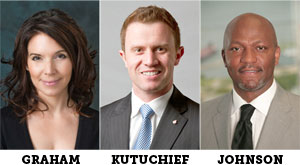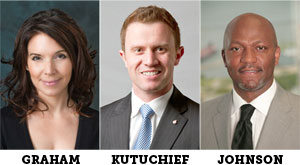
In a new Akron, Knight helps develop the next generation of leadership
The following is the first in a series of reports on Knight Foundation’s work in the communities where it invests. Above: Akron, Ohio. Akron At A Glance
Founded: 1825 City Population: 199,110 Regional Population: 694,960 Median Household Income: $31,835 Diversity Demographics
Caucasian/White: 62.2% African-American: 31.5% Other: 5.3% Age Demographics
under 24: 35.4% 25-44: 30.8% 45+ 33.8% Knight active grants portfolio: 55 projects totaling $52,741,816
Its mouth turning blue, a small child cries “I want my mommy!” But no one is panicking, because the child isn’t real. It’s a teaching tool in the state-of-art simulation center at the new Austen BioInnovation Institute headquarters in Akron. When the center soft launches this month, medical students and others will come to hone their skills amid an array of ambulances, actors, cadavers (both real and synthetic) and computer simulations that can recreate all types of medical emergencies. The goal: create a facility that is the best of its kind in the world.
Akron’s future prosperity depends on delivering upon such innovative visions and attracting the talent to support it. The former “Rubber City” — a nickname from the time America’s four major tire companies were headquartered there — is shedding its industrial past for a future of biomedical discovery, innovation and entrepreneurship.
Knight Foundation will be with the city every step of the way. The foundation was founded in Akron by two of the nation’s leading newspapermen, John S. and James L. Knight, and it is supporting the emergence of the next generation of talent in Akron. Why? Economic revitalization is not built on state-of-the art facilities alone; it requires people to sustain it. Knight is focused on creating an informed and engaged community where talented young professionals can increase the city’s momentum by stepping into leadership roles.
This comes on top of support from the region’s strong institutions, including Akron’s Children’s Hospital, Akron General Health System, Northeast Ohio Medical University, Summa Health System and the University of Akron in establishing the institute.
To help support new civic leadership, the foundation funded a new program with Business Volunteers Unlimited to attract the community’s diverse young business professionals to the nonprofit sector. Jennifer Thomas, Knight’s Akron program director, hopes young leaders will become so deeply engaged the experience will “increase the probability that they will stay and build their lives in Northeast Ohio.”
Young voices are needed everywhere. A sprawling neighborhood surrounding one of the city’s largest institutions, the University of Akron, is a key economic development zone. The Knight-supported University Park Alliance is helping develop retail, residential and economic development opportunities in the 50-block area surrounding the college. Yet Eric Johnson, the alliance’s executive director, says town meetings on important issues attract hundreds, “but most of them are over 50.” Not the best turnout when more than half of the city is younger. Johnson is now working to engage younger participants with events like a business plan competition which was held in May, 2012.
The Akron Neighborhood Trust uses a Knight grant to test the idea that community learning centers can become trusted spaces for engagement of new voices in the community. The Trust envisions these centers, like the one in the neighborhood of Buchtel, as a place for members of the community, service providers and leaders to come together to tackle issues they’re facing.
The Civic Commons, also with Knight support, uses a web-based platform is an online forum where people in the community can gather to participate in conversations that matter. President Mike Shafarenko says the site “actively organizes the conversation around a particular topic and calls on community partners and individuals to get involved.” The Akron Beacon Journal embeds the commons’ conversation widget into selected articles so readers can join in. Shafarenko thinks the average age contributors are in their 30s, “about the time when people start caring about macro-issues in the community like affordable housing and good schools for their kids.”Generation Next in Akron

Three of Akron’s most engaged young leaders talk about how and why they work for the greater good. Read more.
From her stone-solid building on the tree-lined High Street, Suzie Graham, the executive director of the Downtown Akron Partnership, can see the John S. Knight Convention Center and along with a good slice of the downtown many communities would be envious of. She believes the city’s assets — including a treasured performing art theater, a bustling library with 21st century digital media capabilities, an art museum and a brand-new YMCA facility which is exceeding expected membership rates by nearly 50% — need to be both better promoted and expanded. That “would enable the community to attract and retain talent, foster civic pride and celebrate the continued revitalization.” A high priority is bringing more foot traffic, increased retail and residential opportunities.
This kind of “place-making” won’t come without developing the energy, talent and expertise of younger generations. But if that happens, and young professionals remain to take charge of the city, today’s leaders are convinced they will do nothing less than usher in a new era of global competitiveness.
Ask Dr. Frank Douglas, president of the Austen BioInnovation Institute in Akron: “Within five years, I want Akron to be in the top three places that are mentioned when someone wants to know where they should go to talk about biomaterials and how to use them to solve problems … When people say, ‘where can I go to use the most cutting-edge simulation technologies to improve the education of the healthcare team,’ Akron should be at the top of the list. And anywhere in the world someone says, ‘how do you bring a community together to improve the health of that community,’ I want Akron to be at the top of the list.”
Recent Content
-
Communitiesarticle ·
-
Communitiesarticle ·
-
Communitiesarticle ·


